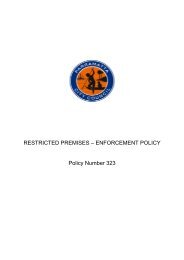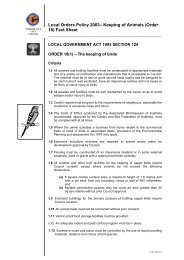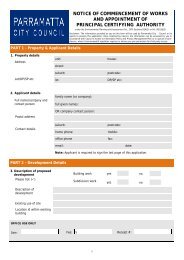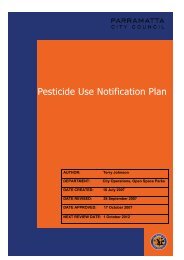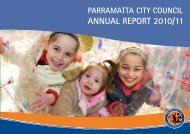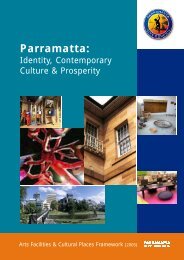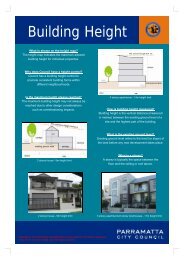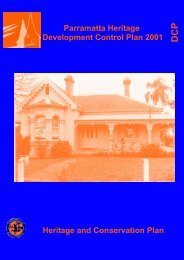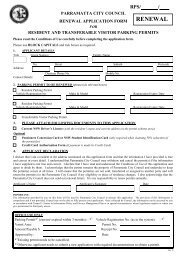Greenhouse Gas Reduction Strategy - Parramatta City Council
Greenhouse Gas Reduction Strategy - Parramatta City Council
Greenhouse Gas Reduction Strategy - Parramatta City Council
You also want an ePaper? Increase the reach of your titles
YUMPU automatically turns print PDFs into web optimized ePapers that Google loves.
PARRAMATTA CITY COUNCIL<br />
GREENHOUSE GAS REDUCTION<br />
PLAN<br />
A STRATEGY FOR THE FUTURE
The <strong>Greenhouse</strong> Effect and<br />
<strong>Parramatta</strong> – Our Vision<br />
for the Future<br />
Our <strong>Greenhouse</strong> Abatement Vision<br />
<strong>Parramatta</strong> – the Leading <strong>City</strong> in New South Wales for reducing greenhouse gas<br />
emissions and addressing the threat of human-induced global warming.<br />
Our Strategic Outcomes for <strong>Greenhouse</strong> Abatement<br />
<strong>Parramatta</strong> will continually reduce greenhouse gas emissions from its own<br />
operations and promote the reduction of emissions from across the local government<br />
area. <strong>Council</strong> will achieve this outcome by setting aggressive reduction goals, and<br />
will meet these goals through the implementation of innovative actions that<br />
incorporate best practice in energy efficiency.<br />
2
Table of Contents<br />
REDUCING GREENHOUSE GAS EMISSIONS –<br />
THE PARRAMATTA CITY COUNCIL STRATEGY 4<br />
- Cities for Climate Protection Program 4<br />
- <strong>Parramatta</strong> <strong>City</strong> <strong>Council</strong>’s <strong>Greenhouse</strong> <strong>Gas</strong> <strong>Reduction</strong> Goals 5<br />
- Meeting the <strong>Reduction</strong> Goals – The Annual <strong>Greenhouse</strong> Action<br />
Plans 5<br />
- Monitoring Success 8<br />
GREENHOUSE GAS EMISSIONS FROM PARRAMATTA CITY<br />
COUNCIL OPERATIONS AND THE LOCAL GOVERNMENT AREA 9<br />
- <strong>Council</strong> Emissions 10<br />
- Local Government Area Emissions 12<br />
THE GREENHOUSE EFFECT AND GLOBAL WARMING 14<br />
- The Enhanced <strong>Greenhouse</strong> Effect 14<br />
- The <strong>Greenhouse</strong> <strong>Gas</strong>es 15<br />
- Sources of <strong>Greenhouse</strong> <strong>Gas</strong> Emissions 16<br />
- Potential Impacts of the Enhanced <strong>Greenhouse</strong> Effect 17<br />
3
Reducing <strong>Greenhouse</strong> <strong>Gas</strong><br />
Emissions – The <strong>Parramatta</strong> <strong>City</strong><br />
<strong>Council</strong> <strong>Strategy</strong><br />
<strong>Parramatta</strong> <strong>City</strong> <strong>Council</strong> is committed to reducing the level of greenhouse gases<br />
emitted from its own operations and the local government area, and has decided to<br />
take a strategic approach to the emissions reduction process. A key component of<br />
this approach is <strong>Council</strong>’s participation in the Cities for Climate Protection Program.<br />
Cities for Climate Protection Program<br />
The Cities for Climate Protection (CCP) Program is a global initiative designed<br />
to reduce greenhouse gas emissions from local government and the community.<br />
The program is administered by the International <strong>Council</strong> for Local Government<br />
Initiatives in association with the Australian <strong>Greenhouse</strong> Office, and is based on<br />
the achievement of five strategic milestones:<br />
Milestone 1:<br />
Milestone 2:<br />
Milestone 3:<br />
Milestone 4:<br />
Milestone 5:<br />
Preparation of an inventory of greenhouse gas emissions for<br />
both corporate (<strong>Council</strong>) and community activities for a baseline<br />
year, and forecast of growth in emissions to the Year 2010<br />
adopting a 'business as usual' scenario.<br />
Setting of an emissions reduction goal.<br />
Preparation and adoption of a Local <strong>Greenhouse</strong> Action Plan<br />
documenting measures to be undertaken to achieve the<br />
reduction goal.<br />
Implementation of the Local <strong>Greenhouse</strong> Action Plan<br />
Monitoring and reporting on the implementation, and review<br />
of the Local <strong>Greenhouse</strong> Action Plan<br />
4
<strong>Parramatta</strong> <strong>City</strong> <strong>Council</strong> joined the CCP program in December 1999 at which time<br />
a resolution was passed by <strong>Council</strong> to commit to the strategic Milestone framework.<br />
<strong>Council</strong> achieved Milestone 1 of the CCP program in November 2001 following<br />
completion of its baseline emissions inventory and emissions growth forecast.<br />
<strong>Council</strong> subsequently achieved Milestone 2 of the Program in May 2002 following<br />
endorsement of a series of targets to bring about a reduction in greenhouse gas<br />
emissions.<br />
<strong>Parramatta</strong> <strong>City</strong> <strong>Council</strong>’s <strong>Greenhouse</strong> <strong>Gas</strong> <strong>Reduction</strong> Goals<br />
<strong>Parramatta</strong> <strong>City</strong> <strong>Council</strong>’s commitment to reducing greenhouse gas emissions is<br />
demonstrated through the reduction goals it has set for its own operations and the<br />
Local Government Area (LGA). Endorsed by <strong>Council</strong> in May 2002 to meet the<br />
Milestone 2 requirements of the CCP Program, the goals are aggressive by<br />
worldwide standards, and establish <strong>Parramatta</strong> <strong>City</strong> <strong>Council</strong> as a leader in<br />
addressing the issue of global warming.<br />
<strong>Parramatta</strong> <strong>City</strong> <strong>Council</strong><br />
<strong>Greenhouse</strong> <strong>Gas</strong> <strong>Reduction</strong> Goals<br />
(1) To reduce <strong>Council</strong> greenhouse gas emissions from 1998-1999 levels by<br />
40 per cent by 2010<br />
(2) To reduce local government area greenhouse gas emissions from 1998<br />
levels by 20 per cent by 2010 as a default CCP target. The goal will be<br />
subject to revision following consultation with the community and other<br />
stakeholders.<br />
Meeting the <strong>Reduction</strong> Goals – The Annual <strong>Greenhouse</strong> Action Plans<br />
The primary means by which <strong>Parramatta</strong> <strong>City</strong> <strong>Council</strong> works toward meeting the<br />
reduction goals is through the development and implementation of Annual<br />
<strong>Greenhouse</strong> Action Plans. The Plans are developed as part of <strong>Council</strong>’s annual<br />
planning process, and set out the energy and greenhouse initiatives <strong>Council</strong> will<br />
implement over the coming twelve months.<br />
5
The actions developed as part of each Annual <strong>Greenhouse</strong> Action Plan can be<br />
categorised into one or more of the following strategic action groups:<br />
Employee Education<br />
• Including energy and greenhouse management as part of the routine<br />
organisation training provided to new employees<br />
• Educating current employees on energy efficiency and greenhouse management<br />
principles so they may become energy-efficiency advocates and individual<br />
leaders in environmental management in their community<br />
<strong>Council</strong> Policy Development and Review<br />
• Developing new policies and adjusting existing policies and processes within<br />
<strong>Council</strong> to become more aligned with <strong>Council</strong>’s greenhouse-gas reduction<br />
initiatives.<br />
Management Systems Development<br />
• Developing management frameworks to capture, review and respond to <strong>Council</strong>’s<br />
energy and greenhouse gas emissions performance results<br />
• Incorporating energy efficiency into existing <strong>Council</strong> management frameworks<br />
Infrastructure Development and Modification<br />
• Incorporating energy efficient design during routine upgrades and overhauls of<br />
<strong>Council</strong>’s assets and infrastructure<br />
• Modifying existing <strong>Council</strong> infrastructure (such as buildings, and vehicle fleet) to<br />
incorporate energy efficiency principles<br />
Community Education<br />
• Developing education resources to raise the awareness of energy and<br />
greenhouse issues across the LGA<br />
• Promoting community-driven solutions, knowledge and awareness to reduce<br />
greenhouse gas emissions<br />
• Identifying and developing strategies for community cost savings and income<br />
generation in the pursuit of reducing LGA greenhouse gas emissions<br />
6
Industry and Other Partnerships<br />
• Providing information to industry within the LGA about reducing energy use and<br />
greenhouse gas emissions from their own operations<br />
• Forming alliances with key industry groups and representatives to improve the<br />
uptake of emissions-reducing initiatives across the LGA<br />
• Forming alliances with key players in sustainable energy industries to provide<br />
better <strong>Council</strong> and industry access to new ideas and technologies<br />
• Developing strategies to enhance a regional approach to reducing greenhouse<br />
gas emissions with other local <strong>Council</strong>s involved in the CCP Program<br />
These groups form the basis for <strong>Council</strong>’s approach to meeting its reduction goals.<br />
Each Annual <strong>Greenhouse</strong> Action Plan contains initiatives covering all of the strategic<br />
action groups.<br />
<strong>Council</strong> recognises that successfully engaging the community and industry in<br />
working to reduce LGA emissions is reliant on <strong>Council</strong> first establishing ‘greenhouse<br />
credibility’ by achieving reductions in its own operations. Consequently the Annual<br />
Action Plans covering the first few years of <strong>Council</strong>’s greenhouse gas abatement<br />
program focus heavily on reducing emissions from <strong>Council</strong> operations.<br />
The initial Plans will also include initiatives relating to the formation of partnerships<br />
with key LGA groups, with future Plans focused on the revision of LGA reduction<br />
goals and implementation of LGA greenhouse initiatives.<br />
7
Monitoring Success<br />
The success of <strong>Parramatta</strong>’s <strong>Greenhouse</strong> <strong>Gas</strong> <strong>Reduction</strong> Plan is measured through<br />
regular monitoring of progress against the reduction targets. This monitoring involves<br />
a combination of regular reviews of energy consumption, together with periodic<br />
reassessment of greenhouse gas emissions from <strong>Council</strong> operations and the LGA.<br />
The data collected from this ongoing monitoring provides <strong>Council</strong> with an accurate<br />
‘snapshot’ of current energy and greenhouse performance. This information is<br />
invaluable when developing relevant and effective Annual <strong>Greenhouse</strong> Action Plans.<br />
8
<strong>Greenhouse</strong> <strong>Gas</strong> Emissions from<br />
<strong>Parramatta</strong> <strong>City</strong> <strong>Council</strong><br />
Operations and the<br />
Local Government Area<br />
<strong>Parramatta</strong> <strong>City</strong> <strong>Council</strong> conducted a study in 2001 to determine the source and<br />
volume of greenhouse gases generated from its own operations and from across the<br />
LGA. The outcome of the study was the development of an inventory of greenhouse<br />
gas emissions and energy use for <strong>Council</strong> and the LGA. The inventory was<br />
completed for the base years of 1998-1999 for the <strong>Council</strong> sector, and 1998 for the<br />
LGA sector. A forecast of emissions growth to 2010 was also completed, based on a<br />
‘business as usual’ scenario. The results of the study are summarised below.<br />
Note: All greenhouse gas emissions are converted to units of carbon dioxide<br />
equivalent (CO 2 -e ) so that gases of different strengths can be compared and added<br />
together. For example, one unit of methane equals 21 CO 2- e .<br />
9
<strong>Council</strong> Emissions<br />
The emissions inventory for the <strong>Council</strong> sector was divided into five categories:<br />
1) Buildings – This sector accounts for emissions from <strong>Council</strong> owned and<br />
operated buildings.<br />
2) Vehicle Fleet – This sector accounts for emissions from fuel use of the<br />
<strong>Council</strong>’s vehicles and plant machinery.<br />
3) Street Lighting – This sector accounts for emissions resulting from street<br />
lighting, including Country Energy/Great Southern Energy street lighting and<br />
<strong>Council</strong> decorative/park lighting.<br />
4) Water – This sector accounts for emissions resulting from the energy used to<br />
pump water for reticulation on <strong>Council</strong> owned property.<br />
5) Waste – This sector accounts for emissions that result from the breakdown of<br />
organic waste<br />
Total emissions produced by <strong>Council</strong><br />
during 1998-1999 - 12,404 tonnes of carbon<br />
dioxide equivalent (CO 2 -e)<br />
Largest specific emitters of greenhouse<br />
gases from <strong>Council</strong> assets/facilities - Streetlights (5,928 tonnes of<br />
CO 2 -e)<br />
- Darcy St Admin Building<br />
(1,125 tonnes of CO 2 -e)<br />
- <strong>Council</strong> Chambers & Hall<br />
(639 tonnes of CO 2 -e)<br />
- <strong>Council</strong>’s passenger<br />
vehicles (602 tonnes of<br />
CO 2 -e)<br />
- <strong>Parramatta</strong> Library (450<br />
tonnes of CO 2 -e)<br />
Primary energy source of greenhouse<br />
gas emissions from <strong>Council</strong> operations - Electricity (86%)<br />
Expected emissions in 2010 - 12,773 tonnes of CO 2 -e (3%<br />
increase from 1998-1999)<br />
10
Waste<br />
>1%<br />
Water<br />
>1%<br />
Buildings<br />
39%<br />
Streetlights<br />
49%<br />
Vehicle Fleet<br />
12%<br />
Break-up of <strong>Greenhouse</strong> <strong>Gas</strong> Emissions by operating area from <strong>Parramatta</strong> <strong>City</strong> <strong>Council</strong><br />
Operations during 1998-1999<br />
7000<br />
6000<br />
5927.8<br />
6126.7<br />
5000<br />
4872.9<br />
5127.6<br />
Equvalent CO 2 (Tonnes)<br />
4000<br />
3000<br />
2000<br />
1526.6<br />
1439.1<br />
1000<br />
0<br />
-1000<br />
33.8 35.5 -30 -30<br />
Buildings Vehicle Fleet Streetlights Water Waste<br />
Sector<br />
Equivalent CO2 (tonnes) 1998/1999 Equivalent CO2 (tonnes) 2010<br />
<strong>Greenhouse</strong> <strong>Gas</strong> Emissions from <strong>Parramatta</strong> <strong>City</strong> <strong>Council</strong> Operations during 1998-1999,<br />
and Forecast of Emissions Growth to 2010 (CO 2 Tonnes)<br />
11
Local Government Area Emissions<br />
The emissions inventory for the LGA sector was divided into five categories. These<br />
categories, and the associated emissions were:<br />
1) Residential - 336,064 tonnes of CO 2 -e<br />
2) Commercial - 343,713 tonnes of CO 2 -e<br />
3) Industrial - 1,615,699 tonnes of CO 2 -e<br />
4) Transport - 333,536 tonnes of CO 2 -e<br />
5) Waste - 73 tonnes of CO 2 -e<br />
Total emissions produced by the LGA<br />
during 1998 - 2,629,085 tonnes of CO 2 -e<br />
Source of highest emissions<br />
- Industrial Sector<br />
Expected emissions in 2010 - 3,001,665 tonnes of CO 2 -e<br />
(14% increase from 1998<br />
Transport<br />
13%<br />
Waste<br />
1%<br />
Residential<br />
13%<br />
Commercial<br />
13%<br />
Industrial<br />
60%<br />
Break-up of <strong>Greenhouse</strong> <strong>Gas</strong> Emissions by operating area from the <strong>Parramatta</strong> Local<br />
Government Area during 1998<br />
12
<strong>Greenhouse</strong> <strong>Gas</strong> Emissions from the <strong>Parramatta</strong> <strong>City</strong> Local Government Area during 1998,<br />
and Forecast of Emissions Growth to 2010 (CO 2 Tonnes)<br />
1800000<br />
1600000<br />
1616848<br />
1569199.9<br />
1400000<br />
1200000<br />
Equivalent CO 2<br />
1000000<br />
800000<br />
600000<br />
400000<br />
500696.3<br />
416417.8<br />
336598.2 344009.6<br />
334135.5<br />
499137<br />
200000<br />
0<br />
-200000<br />
-16266.7 -20085.8<br />
Residential Commercial Industrial Transport Waste<br />
Sector<br />
Equivalent CO2 (tonnes) 1998 Equivalent CO2 (tonnes) 2010<br />
13
The <strong>Greenhouse</strong> Effect and<br />
Global Warming<br />
The Enhanced <strong>Greenhouse</strong> Effect<br />
<strong>Greenhouse</strong> gases are a natural part of the atmosphere. They trap the sun's<br />
warmth, and maintain the earth's surface temperature at a level necessary to<br />
support life. The problem we now face is that human actions - particularly the<br />
burning of fossil fuels (coal, oil and natural gas) and land clearing - are increasing<br />
the concentrations of these gases, creating the prospect of increased global<br />
warming. This is the enhanced greenhouse effect.<br />
14
The <strong>Greenhouse</strong> <strong>Gas</strong>es<br />
Water vapour is the most important greenhouse gas, but human activities make<br />
little direct impact on the amount in the atmosphere. Humans have most impact<br />
on emissions of carbon dioxide, methane and nitrous oxide. Also making a<br />
relatively small contribution to climate change are various artificial chemicals<br />
such as halocarbons.<br />
The Primary <strong>Greenhouse</strong> <strong>Gas</strong>es<br />
Carbon dioxide (CO 2 )<br />
Carbon dioxide emissions resulting from direct human activities have altered the<br />
global carbon cycle. As a result the CO 2 concentration in the atmosphere is now<br />
about 30% higher than 200 years ago. Burning of oil, coal and natural gas, and<br />
the clearing and burning of vegetation are the main causes of the rise. This gas<br />
makes the biggest contribution to the enhanced greenhouse effect (about 70%).<br />
Nitrous oxide (N 2 O)<br />
Burning of vegetation, industrial emissions, and effects of agriculture on soil<br />
processes have contributed to an increase of about 15% in the N 2 O (5% in 1996<br />
inventory) concentration in the atmosphere over the past 200 years.<br />
Methane (CH 4 )<br />
CH 4 makes the next biggest contribution to global warming--some 20% of the<br />
total. Its concentration has risen by about 145% over the past 200 years. The<br />
digestive processes of cattle, rice cultivation, venting of natural gas, and waste<br />
decomposition in landfills are some of the major sources of CH 4 emissions.<br />
Halocarbons<br />
The phase-out of chlorofluorocarbons (CFCs) to protect the ozone layer should<br />
see concentrations steadily decline. Other halocarbons of greenhouse<br />
significance include perfluorocarbons (PFCs) emitted during aluminium<br />
production.<br />
15
Sources of <strong>Greenhouse</strong> <strong>Gas</strong> Emissions<br />
Using energy from fossil fuels<br />
When oil, gas or coal burns, carbon in the fuel combines with oxygen from the air<br />
to make carbon dioxide. Methane is generated from coal mining operations and<br />
from some natural gas pipelines. <strong>Greenhouse</strong> gases are also released during oil<br />
and gas production.<br />
Vegetation cover<br />
Growing plants absorb carbon dioxide from air and are greenhouse gas "sinks".<br />
Over decades, forests build up an important store of carbon in trees, soil and<br />
fallen leaves. When land is cleared, much of this is rapidly converted back to<br />
carbon dioxide by burning or decay.<br />
Farming<br />
Animals, particularly cattle and sheep, produce methane as food breaks down<br />
inside them. Some fertilisers release nitrous oxide. Rice production in paddy<br />
fields generates methane under water.<br />
Breakdown of wastes<br />
When organic materials, food scraps, garden wastes and paper are dumped in<br />
landfills, their decay generates carbon dioxide and methane. Sewage and<br />
wastewater treatment plants also release these gases as they break down<br />
wastes.<br />
16
Industrial processes<br />
Cement and aluminium production, and some other processes involve chemical<br />
reactions which produce greenhouse gases.<br />
Potential Impacts of the Enhanced <strong>Greenhouse</strong> Effect<br />
As the accumulation of greenhouse gases in the atmosphere increases, the amount<br />
of heat trapped in the atmosphere will also increase. While there is general scientific<br />
agreement that human activities are causing changes in climatic patterns, there is still<br />
some debate as to the extent to which the greenhouse effect is contributing to<br />
atmospheric changes.<br />
The International Panel on Climate Change (IPCC) brings together the world’s<br />
leading scientists to report on climate change. In the latest Assessment Report of the<br />
IPCC (2001) the possible effects of global warming were recognised as:<br />
• An increase in the global average surface temperature relative to 1990. This is<br />
projected to increase between 1.4°C to 5.8 3.5°C by 2100,<br />
• an increase in air turbulence (higher incidences of cyclones and storms),<br />
• changes in rainfall patterns, and<br />
• an increase in sea level due to warmer ocean temperatures. Average sea level is<br />
projected to rise about 0.09 meters above present levels by 2100.<br />
The IPCC has projected changes in climate will result in significant, often<br />
adverse, impacts on many ecological systems and socio-economic sectors,<br />
including food supply, water resources and human health. In some cases the<br />
impacts are potentially irreversible - developing countries and small island<br />
countries are typically more vulnerable to climate change. The consequences on<br />
society of these effects may include disruption to agriculture, flooding of low lying<br />
coastal areas, ecosystem stress due to rapid climate change, increased demand<br />
for fresh water and the spread of tropical diseases.<br />
17




